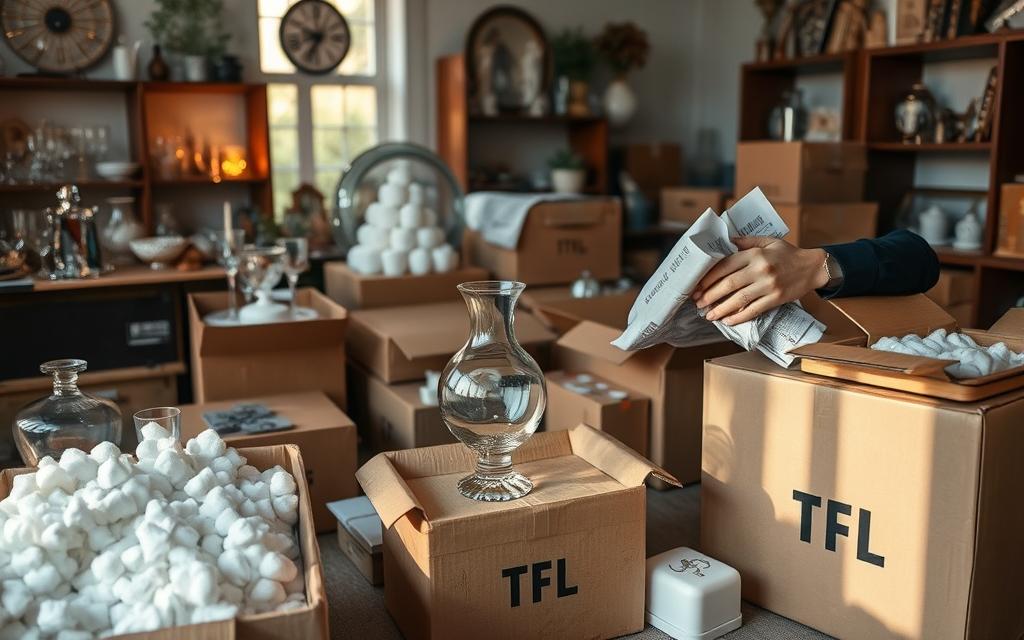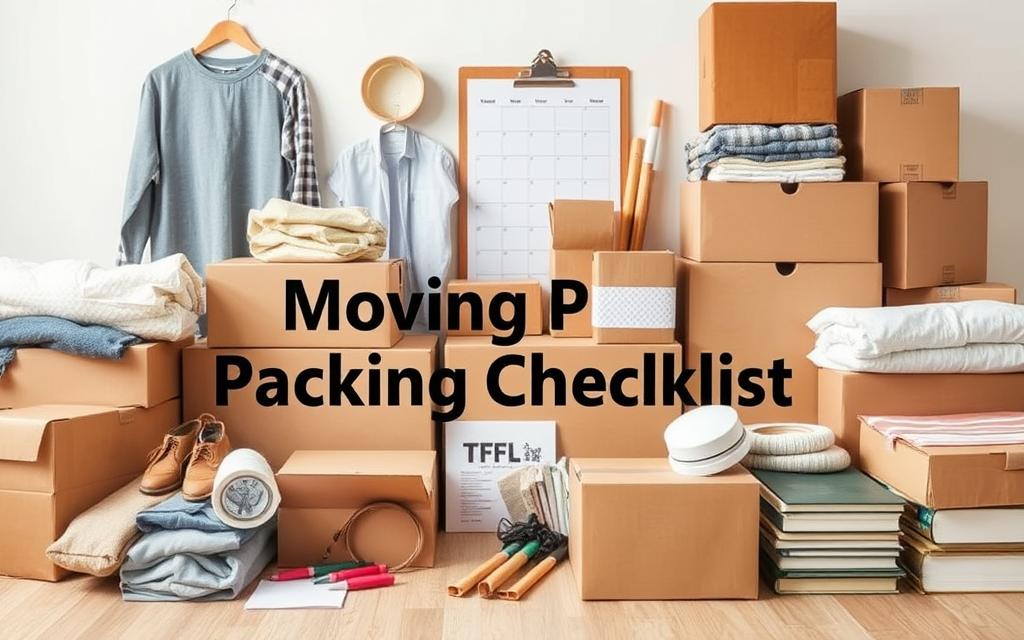Moving to a new home can feel overwhelming. But, with the right checklist, it can be easy. Let’s explore how to pack for a move to make it smooth.
First, gather all the essential supplies. You’ll need boxes of different sizes, tape, markers, and protective materials. Also, get plastic bags for small items and non-perishables. A detailed packing list is your guide to success.
Start packing items you don’t use often, like seasonal clothes or kitchenware you rarely use. This way, you can keep your daily life normal while packing. Always put crushed paper at the bottom of each box for extra safety.
Labeling boxes is key. Write what’s inside and the room it goes to. Using colors to label can make unpacking quicker and less stressful. This approach will help you settle in faster.
Prepare a box of essentials for your first night in the new home. Put in toiletries, a change of clothes, and important papers. This box should be easy to find, making your first night comfortable.
By using this checklist, you’ll be ready for moving day. The main thing is to start early and stay organized. Good luck with packing!
Essential Moving Supplies: Your Packing Arsenal
Creating a detailed moving house packing checklist is key for a smooth move. Let’s look at the must-have supplies you’ll need.
Boxes and Containers: Choosing the Right Sizes
Choosing the right box sizes is crucial for packing efficiently. Small boxes are perfect for heavy items like books. Medium boxes are great for toys and kitchen gadgets. Large boxes are best for lightweight items such as comforters and pillows. And don’t forget wardrobe boxes for keeping clothes wrinkle-free during transport.
Packing Materials: Beyond Bubble Wrap
Bubble wrap is excellent for protecting fragile items, but there’s more. Packing paper is better at preventing stains than newspapers. Furniture pads protect sofas and tables from scratches. Mattress covers keep beds safe from dust and moisture during the move.
Tools and Accessories: Making Packing Efficient
Have scissors, box cutters, and tape dispensers ready for easy packing. Use permanent markers for clear labels. Color-coded labels help identify rooms, making your packing list more organized.
| Box Type | Best For | Special Features |
|---|---|---|
| Small | Books, heavy items | Easy to lift |
| Medium | Toys, kitchen gadgets | Versatile use |
| Large | Comforters, pillows | Ideal for light items |
| Wardrobe | Hanging clothes | Built-in rod |
| Dish pack | Kitchenware | Compartmentalized |
A well-prepared packing list ensures you have everything you need. This makes your move less stressful and more organized.
Room-by-Room Packing Strategy: Tackling Your Home
Getting ready for a move? A well-planned packing strategy is crucial. By packing your home room by room, you make the process easier and ensure you don’t forget anything. Let’s look at some top tips for packing efficiently, focusing on each area of your house.
Begin with the home office, packing electronics and securing important papers. In the kitchen, clean appliances first and wrap fragile items in bubble wrap. For the dining room, use kitchen towels or linens to protect china and glassware. Don’t forget to remove lamp shades and wrap mirrors with blankets in the living room.
In bedrooms, hang clothes and use luggage for loose items. Pack bathroom essentials last, making sure toiletries are sealed to avoid leaks. This method makes packing for a move efficient.
“Heavy belongings should be packed on the bottom of moving boxes, while lighter items should be placed on top to balance weight and reduce the risk of damage.”
Here are some tips to save time:
- Start planning your move 8 weeks in advance
- Begin packing 14 to 21 days before moving day
- Aim to finish packing 1 week prior to the move
- Pack items from one room together for easier unpacking
- Use color-coding or room-specific labeling on boxes
| Timeframe | Items to Pack |
|---|---|
| 5+ weeks out | Items in storage |
| 4-5 weeks out | Out-of-season clothes |
| 3-4 weeks out | Fine china, crystal, silver |
| 2-3 weeks out | Books, artwork, home decor |
| 1-2 weeks out | Toys, hobbies |
| 1 week out | Clothing, shoes, jewelry |
Packing a three-bedroom home usually takes three to five days of focused work. By using this room-by-room strategy and timeline, you’ll have a smooth and stress-free move.
How to Pack for a Move Checklist: A Week-by-Week Guide
Planning a move can feel overwhelming. But, with the right moving essentials checklist, it can be smoother. Our ultimate moving checklist helps you tackle tasks one week at a time. This ensures you’re ready for your big day.
8 Weeks Before: Planning and Decluttering
Begin your moving journey early. Most people start preparing 4 weeks before moving day. Here’s how to get ahead:
- Research moving companies
- Make a moving budget
- Declutter your home to better estimate packing needs
- Make an inventory of your belongings
4 Weeks Before: Room-by-Room Packing
With a month to go, start packing. Begin with rooms you don’t use often:
- Order packing supplies, like free boxes from local businesses
- Pack items you don’t need right away
- Label boxes by room for easy unpacking
- Take photos of furniture before taking it apart
1 Week Before: Final Preparations
The final week starts the countdown! Here’s what to do:
- Pack essentials and prepare a “comfort box” for each family member
- Double-check moving details with your chosen company
- Clean your current home
- Arrange time off work, as most movers do
| Time Before Move | Key Tasks | Percentage of Movers |
|---|---|---|
| 8 Weeks | Research moving companies | 74% |
| 6 Weeks | Book movers and storage units | 78% |
| 4 Weeks | Start room-by-room packing | 63% |
| 1 Week | Final packing and cleaning | 92% |
Packing Techniques for Fragile Items: Ensuring Safe Transit

Packing fragile items is key to a successful move. With the right methods, you can lower the chance of damage. Begin by wrapping each fragile item in clean paper or bubble wrap. This is vital for protecting things like glassware and ceramics.
Next, add a layer of padding at the box’s bottom with crumpled paper. Put heavier items at the bottom and lighter ones on top. Fill any gaps with more packing material to stop things from moving around. For added safety, put small boxes of fragile items inside bigger ones, with padding in between.
Remember to mark your boxes well. Use “FRAGILE” stickers and show which side should face up. This tells movers to be extra careful. If an item is very valuable or can’t be replaced, consider bringing it with you.
- Wrap each item individually
- Use cushioning at the box bottom
- Pack heavier items first
- Fill empty spaces
- Label boxes clearly
By following these steps, your fragile items will reach their new home safely. Remember, spending a bit more time packing can prevent future stress and save money.
Labeling and Organizing: Streamlining Your Unpacking Process
Having a well-organized packing list for moving can change everything when you get to your new place. By using smart labeling and organizing, you’ll save time and lower stress during unpacking.
Color-Coding System: Simplify Room Identification
Give each room in your new home a unique color. Use colored tape or markers to label the boxes. This way, movers can quickly see where each box goes, making unloading faster.
Inventory Lists: Keeping Track of Your Belongings
Make detailed inventory lists for each box in your moving checklist. List what’s inside and the room it goes to. Keep a master list in a safe spot. This helps you keep track of your stuff and makes sure nothing gets lost.
Priority Labeling: Identifying Essential Boxes
Use a priority system to mark boxes with things you need right away. Label these as “Open First” or “Essential” so you can find them easily when you arrive.
| Label Color | Room | Priority Level |
|---|---|---|
| Red | Kitchen | High |
| Blue | Bedroom | Medium |
| Green | Living Room | Low |
| Yellow | Bathroom | High |
Make sure to label boxes on all sides for easy spotting. Think about putting signs on doors at your new place to help movers put boxes in the right rooms. With these tips, your moving checklist will turn into a key tool for a smooth move.
Moving Day Essentials: What to Keep Handy
Creating a packing list is key, but don’t overlook your moving essentials checklist. Pack a separate suitcase with things you’ll need right away. This method, developed from 9 moves over 16 years, helps you avoid searching through boxes for must-haves.

Your “Open First” box should have essentials for living and eating. Include air mattresses, bedding, shower curtains, and basic cleaning supplies. Also, pack a tool kit, first aid kit, and garbage bags. For meals, add disposable plates and utensils, and think about a folding table for comfort.
Keep important documents, cash, and credit cards handy. Scan copies for easy access. Remember your keys – they can easily get lost in the chaos. Use large ziplock bags for toiletries to prevent spills.
- Clothing for a few days
- Chargers and essential electronics
- Pet supplies if needed
- Snacks and water
- Basic cookware and a coffee maker
Planning ahead helps you avoid the stress of looking for essentials. This moving day strategy lets you start settling in right away. It makes your new house feel like home from the start.
Unpacking Tips: Settling into Your New Home
After finishing your ultimate moving checklist, it’s time to unpack. Begin with the basics – bedding, toiletries, and kitchen items. These essentials will make your first night comfy. Next, arrange major furniture before opening boxes. This method helps organize your new space.
Unpack room by room, starting with the kitchen and bathroom. Check items against your list to make sure nothing’s missing. Use empty boxes to save space and keep things tidy. Cleaning as you unpack helps keep your new home neat. Remember, unpacking is a long process. Set a realistic timeline and take it easy.
Update your address with contacts and services next. This step is often missed but crucial for a smooth move. Consider ordering groceries for your first day to avoid shopping stress. By packing and unpacking smartly, you’ll settle into your new home easily and comfortably.
Source Links
- https://www.constellation.com/energy-101/moving/moving-packing-checklist.html
- https://www.mayflower.com/moving-tips/moving-checklists/packing-101
- https://deluxemoving.ca/the-essential-packing-list-materials-you-need-for-a-seamless-move/
- https://blog.nationwide.com/family-life/moving/packing-tips-for-moving/
- https://www.swamprabbitmoving.com/blog/packing-tips-apartment
- https://www.adamsvanlines.com/best-packing-checklist-when-moving
- https://www.pods.com/blog/what-to-pack-first
- https://updater.com/moving-tips/the-most-epic-moving-checklist-in-the-history-of-moving-checklists/
- https://www.zipmoving.us/blog/moving-timeline-week-by-week-checklist/
- https://www.mypromoversdc.com/blog/handling-fragile-items-move
- https://www.moverscorp.com/moving_guide/packing_fragile_items/
- https://www.petesmovingservices.com/moving-tips/2024/february/the-dos-and-donts-of-moving-fragile-items-protec/
- https://helenpainter.com/moving-guide/
- https://www.agmoving.com/how-to-pack-for-a-move-a-checklist-by-room.html
- https://www.mabeys.com/moving-storage/blog-details/cross-country-move-checklist/
- https://thehomesihavemade.com/moving-essentials-must-have-items-for/
- https://ralphstransfer.com/moving-essentials-checklist-how-to-pack-for-a-move/
- https://www.lifestorage.com/blog/moving/moving-essentials/
- https://www.forbes.com/home-improvement/moving-services/moving-in-checklist/
- https://www.puremovers.com/blog/checklist-for-moving-into-a-new-house/
- https://www.hellolanding.com/blog/how-to-unpack-after-a-move-a-step-by-step-guide/

